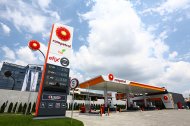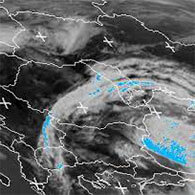LOCAL EXPORTERS - BUSINESS INCREASES, BUT WITH HIGHER COMMERCIAL RISKS, THAT MAY AFFECT THE LOCAL BUSINESS PARTNERS
LOCAL EXPORTERS - BUSINESS INCREASES, BUT WITH HIGHER COMMERCIAL RISKS, THAT MAY AFFECT THE LOCAL BUSINESS PARTNERS
25 Mar, 2014 12:41
ZIUA de Constanta
 1166
Marime text
1166
Marime text
 1166
Marime text
1166
Marime text
Bucharest, 25th March 2014
After a relative stagnation in 2012, the exports registered in 2013 an annual increase of 12%. However, Romanian exporting companies show significant commercial risks that may affect the local business partners. In this difficult economic context, in order to meet the companies’ needs of analyzing their international business partners, Coface developed a product dedicated to this segment: Coface Select online credit reports.
Exports in Romania - significant evolution in 2013; 12% growth compared to 2012
Lately, the export has been one of the main factors that have supported the economic growth. Its revival is characteristic to the emerging countries in a post-crisis period, when the demand from developed countries is experiencing a structural change. Specifically, within a crisis period, consumers embrace the general trend of replacing luxury goods with cheaper and low quality products. This feature marked the evolution of the Romanian exports during 2013, while they were heavily dependent on the automotive industry and the main destination countries were the developed ones. Therefore, after a relative stagnation in 2012, the exports have registered in 2013 an annual increase of 12% (real growth, gross series), overtaking the imports, that increased by only 2%.
The exports’ advance, alongside a general depreciation trend of the local currency, indicates a significant commercial development of the domestic exporters. Despite this, we should question the sustainability of those increases, namely the extent to which these are found in the final added value and liquidity.
To what extend these increases creates added value in the long term? How monetary are these increases and what about their quality? These questions are even more essential now because of the exports’ role that is increasing within the economic growth in the medium-long term.
Romanian exporters show significant commercial risks that may affect the local business partners
To answer the questions above, Coface has selected a sample of 400 companies, representing some of the leading domestic exporters (depending on the total turnover registered in 2012). According to their financial statements for 2012, they registered a total turnover of approx. 35 BEUR (15% of the turnover of all companies in Romania), meaning an average turnover of 86 MEUR. These companies are very important to the local economy, given that even excluding the largest exporters (the largest 6 companies, turnover > 1 BEUR generated a share of 40% within the sample), the mean of the annual turnover for the remaining companies is 52 MEUR.
Analyzing the financial results for 2011 - 2012 for the selected companies, we noticed that:
6 companies out of 10 registered increases in their turnover, and 2 of them stood out with an advance of over 25%. Within the overall sample, the turnover increased in 2012 with 3%. Eliminating the effect of the most important 6 companies in the sample, the average turnover registered a similar advance of 2.5%.
The commercial dynamics was not proportionally converted within the increase of the net result, given that only 5 companies out of 10 registered increases in net profit.
Receivables registered an average advance of 1%, slower than the dynamics of the overall turnover. However, eliminating the most important 6 companies from the sample, the total value of the receivables for the remaining companies have increased with 13%. This is the first warning sign that indicates a business growth amid growing commercial risks.
The DSO of the exporters’ receivables increased from 65 days in 2011 to 75 days in 2012. Nearly 6 analyzed companies out of 10 faced an extension of the DSO, of which 3.5 registered an advance of over 25%. Extending the DSO transposed into a pressure of reducing the effective liquidity of these companies by 31%. Two-thirds of these companies have balanced the need for liquidity through an increase in short-term debt, especially to suppliers.
Basically, we are talking about 4 exporters out of 10 within the sample that showed a significant increase of the DSO and who have further implemented this need of financing to suppliers by a late payment of the invoices. Due to the fact that these exporting companies do not import raw materials, so most of their suppliers are local, we can relate to a spread of the commercial financing from inland to the outside. Due to the lack of necessary data, we cannot quantify if the exporters’ suppliers are domestic or international. Certainly, some of them are Romanian companies that had to accept an extensive DSO, because their customers, the exporting firms, have commercially credited their international clients.
This dynamic attracts a significant systemic risk because local firms are not only exposed to the local partners’ payment behavior, but also registered indirect exposure (masked) to international companies by delivering products/ services to exporters who accepted extensive DSO from their international partners. Thus, a deterioration of the payment discipline within major commercial partners (Germany, France, Italy, and Hungary) will be faster propagated in the real economy.
What are the consequences of this policy of aggressive growth?
20 companies out of 400 within the sample have suspended their activity during 2013.
Within the request of its business partners, Coface analyzed in 2013, 350 companies out of 400 from the sample mentioned above. Based on its credit reports, individually prepared for each company, we have noticed the following:
40% of the analyzed companies show a high or above the average risk of insolvency.
30% of them do not complete the payments according to their contractual terms.
For 30% of these companies, Coface does not recommend a commercial credit exposure (payment on due date).
Coface supports the Romanian exporters through Coface Select online credit reports
Due to this difficult economic context, Coface helps companies to analyze their international business partners with a dedicated product for this market segment: Coface Select.
Coface Select is an innovative tool for prospecting international customers and providing fast access to online information. In order to meet this need, Coface now offers standardized and compact reports on companies in 22 countries within Central and Western Europe: Belgium, Bulgaria, Croatia, Czech Republic, Estonia, Finland, France, Germany, Hungary, Ireland, Latvia, Lithuania, Netherlands, Norway, Poland, Romania, Serbia, Slovakia, Slovenia, Sweden, Ukraine and United Kingdom.
Coface Select Reports contain the following information: company details, risk assessment (low, medium, high) according to the latest analysis of the company, field of activity, management team and shareholders, alongside the most important financial data.
This product is unique in the market due to the following options: online access 24/24 & 7/7, the possibility to select the countries of interest that can be included in a predefined package, directly customized by the customer, through a standardized layout, regardless of the partner’s location. Moreover, the report contains an innovative tool, the Quick Rate, which shows the creditworthiness and is expressed in the form of a traffic light system. This easy and instant tool allows quick and efficient decision making. Coface Select is particularly useful for importers and exporters when selecting potential business partners and monitoring existing customers.
“Instant reports at the click of a mouse together with the Quick Rate distinguish Coface Select from other information solutions. This is an excellent tool for very accurate prospecting for exporters. Coface Select can help the companies to find interesting business partner abroad and grow their business. Our aim with this product innovation is to continue to support our customers to improve their efficiency and shorten their decision making”, underlined the benefits of Coface Select, Ms. Katarzyna Kompowska, Executive Manager, Coface Central Europe.
“The contribution of exports within Romanian economy in 2013 was extremely important and will also play a significant role in 2014, but an increase of exports with 12% is not enough, because there is registered a higher trend of cashing invoices from external partners later than usual, which can be translated into a greater financing effort from suppliers. In any business, not only the turnover’s increase is important, but also the invoices payments in due time and the suppliers’ payment. Precisely for this reason, the need of information regarding international partners plays a critical role within the success of Romanian exports.”, said Constantin Coman, Country Manager, Coface Romania.
About Coface
The Coface Group, a worldwide leader in credit insurance, offers companies around the globe solutions to protect them against the risk of financial default of their clients, both on the domestic market and for export. In 2012, the Group posted a consolidated turnover of €1.6 billion. 4,400 staff in 66 countries provides a local service worldwide. Each quarter, Coface publishes its assessments of country risk for 160 countries, based on its unique knowledge of companies’ payment behavior and on the expertise of its 350 underwriters located close to clients and their debtors.
In France, Coface manages export public guarantees on behalf of the French state.
Coface is a subsidiary of Natixis, corporate, investment management and specialized financial services arm of BPCE Group.
www.coface.com
After a relative stagnation in 2012, the exports registered in 2013 an annual increase of 12%. However, Romanian exporting companies show significant commercial risks that may affect the local business partners. In this difficult economic context, in order to meet the companies’ needs of analyzing their international business partners, Coface developed a product dedicated to this segment: Coface Select online credit reports.
Exports in Romania - significant evolution in 2013; 12% growth compared to 2012
Lately, the export has been one of the main factors that have supported the economic growth. Its revival is characteristic to the emerging countries in a post-crisis period, when the demand from developed countries is experiencing a structural change. Specifically, within a crisis period, consumers embrace the general trend of replacing luxury goods with cheaper and low quality products. This feature marked the evolution of the Romanian exports during 2013, while they were heavily dependent on the automotive industry and the main destination countries were the developed ones. Therefore, after a relative stagnation in 2012, the exports have registered in 2013 an annual increase of 12% (real growth, gross series), overtaking the imports, that increased by only 2%.
The exports’ advance, alongside a general depreciation trend of the local currency, indicates a significant commercial development of the domestic exporters. Despite this, we should question the sustainability of those increases, namely the extent to which these are found in the final added value and liquidity.
To what extend these increases creates added value in the long term? How monetary are these increases and what about their quality? These questions are even more essential now because of the exports’ role that is increasing within the economic growth in the medium-long term.
Romanian exporters show significant commercial risks that may affect the local business partners
To answer the questions above, Coface has selected a sample of 400 companies, representing some of the leading domestic exporters (depending on the total turnover registered in 2012). According to their financial statements for 2012, they registered a total turnover of approx. 35 BEUR (15% of the turnover of all companies in Romania), meaning an average turnover of 86 MEUR. These companies are very important to the local economy, given that even excluding the largest exporters (the largest 6 companies, turnover > 1 BEUR generated a share of 40% within the sample), the mean of the annual turnover for the remaining companies is 52 MEUR.
Analyzing the financial results for 2011 - 2012 for the selected companies, we noticed that:
6 companies out of 10 registered increases in their turnover, and 2 of them stood out with an advance of over 25%. Within the overall sample, the turnover increased in 2012 with 3%. Eliminating the effect of the most important 6 companies in the sample, the average turnover registered a similar advance of 2.5%.
The commercial dynamics was not proportionally converted within the increase of the net result, given that only 5 companies out of 10 registered increases in net profit.
Receivables registered an average advance of 1%, slower than the dynamics of the overall turnover. However, eliminating the most important 6 companies from the sample, the total value of the receivables for the remaining companies have increased with 13%. This is the first warning sign that indicates a business growth amid growing commercial risks.
The DSO of the exporters’ receivables increased from 65 days in 2011 to 75 days in 2012. Nearly 6 analyzed companies out of 10 faced an extension of the DSO, of which 3.5 registered an advance of over 25%. Extending the DSO transposed into a pressure of reducing the effective liquidity of these companies by 31%. Two-thirds of these companies have balanced the need for liquidity through an increase in short-term debt, especially to suppliers.
Basically, we are talking about 4 exporters out of 10 within the sample that showed a significant increase of the DSO and who have further implemented this need of financing to suppliers by a late payment of the invoices. Due to the fact that these exporting companies do not import raw materials, so most of their suppliers are local, we can relate to a spread of the commercial financing from inland to the outside. Due to the lack of necessary data, we cannot quantify if the exporters’ suppliers are domestic or international. Certainly, some of them are Romanian companies that had to accept an extensive DSO, because their customers, the exporting firms, have commercially credited their international clients.
This dynamic attracts a significant systemic risk because local firms are not only exposed to the local partners’ payment behavior, but also registered indirect exposure (masked) to international companies by delivering products/ services to exporters who accepted extensive DSO from their international partners. Thus, a deterioration of the payment discipline within major commercial partners (Germany, France, Italy, and Hungary) will be faster propagated in the real economy.
What are the consequences of this policy of aggressive growth?
20 companies out of 400 within the sample have suspended their activity during 2013.
Within the request of its business partners, Coface analyzed in 2013, 350 companies out of 400 from the sample mentioned above. Based on its credit reports, individually prepared for each company, we have noticed the following:
40% of the analyzed companies show a high or above the average risk of insolvency.
30% of them do not complete the payments according to their contractual terms.
For 30% of these companies, Coface does not recommend a commercial credit exposure (payment on due date).
Coface supports the Romanian exporters through Coface Select online credit reports
Due to this difficult economic context, Coface helps companies to analyze their international business partners with a dedicated product for this market segment: Coface Select.
Coface Select is an innovative tool for prospecting international customers and providing fast access to online information. In order to meet this need, Coface now offers standardized and compact reports on companies in 22 countries within Central and Western Europe: Belgium, Bulgaria, Croatia, Czech Republic, Estonia, Finland, France, Germany, Hungary, Ireland, Latvia, Lithuania, Netherlands, Norway, Poland, Romania, Serbia, Slovakia, Slovenia, Sweden, Ukraine and United Kingdom.
Coface Select Reports contain the following information: company details, risk assessment (low, medium, high) according to the latest analysis of the company, field of activity, management team and shareholders, alongside the most important financial data.
This product is unique in the market due to the following options: online access 24/24 & 7/7, the possibility to select the countries of interest that can be included in a predefined package, directly customized by the customer, through a standardized layout, regardless of the partner’s location. Moreover, the report contains an innovative tool, the Quick Rate, which shows the creditworthiness and is expressed in the form of a traffic light system. This easy and instant tool allows quick and efficient decision making. Coface Select is particularly useful for importers and exporters when selecting potential business partners and monitoring existing customers.
“Instant reports at the click of a mouse together with the Quick Rate distinguish Coface Select from other information solutions. This is an excellent tool for very accurate prospecting for exporters. Coface Select can help the companies to find interesting business partner abroad and grow their business. Our aim with this product innovation is to continue to support our customers to improve their efficiency and shorten their decision making”, underlined the benefits of Coface Select, Ms. Katarzyna Kompowska, Executive Manager, Coface Central Europe.
“The contribution of exports within Romanian economy in 2013 was extremely important and will also play a significant role in 2014, but an increase of exports with 12% is not enough, because there is registered a higher trend of cashing invoices from external partners later than usual, which can be translated into a greater financing effort from suppliers. In any business, not only the turnover’s increase is important, but also the invoices payments in due time and the suppliers’ payment. Precisely for this reason, the need of information regarding international partners plays a critical role within the success of Romanian exports.”, said Constantin Coman, Country Manager, Coface Romania.
About Coface
The Coface Group, a worldwide leader in credit insurance, offers companies around the globe solutions to protect them against the risk of financial default of their clients, both on the domestic market and for export. In 2012, the Group posted a consolidated turnover of €1.6 billion. 4,400 staff in 66 countries provides a local service worldwide. Each quarter, Coface publishes its assessments of country risk for 160 countries, based on its unique knowledge of companies’ payment behavior and on the expertise of its 350 underwriters located close to clients and their debtors.
In France, Coface manages export public guarantees on behalf of the French state.
Coface is a subsidiary of Natixis, corporate, investment management and specialized financial services arm of BPCE Group.
www.coface.com
Urmareste-ne pe Grupul de Whatsapp
Comentarii
 Fondul Documentar Dobrogea de ieri și de azi
Fondul Documentar Dobrogea de ieri și de azi




















